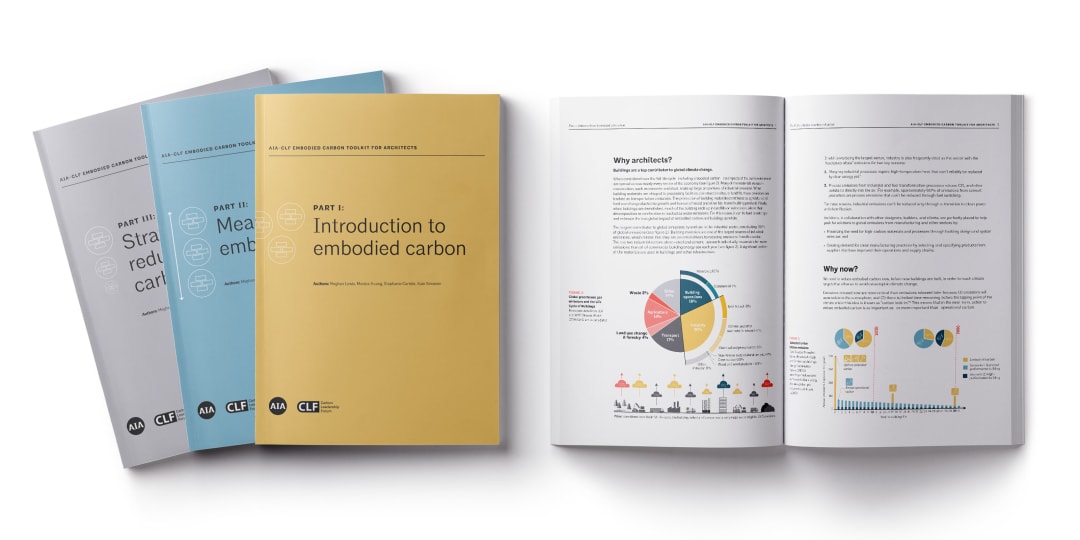Architects are critical to addressing the climate crisis through reducing both operational and embodied carbon on their projects.
The AIA-CLF Embodied Carbon Toolkit for Architects serves to provide architects with an overview and the necessary steps to be taken to reduce embodied carbon in their projects.
The AIA-CLF Embodied Carbon Toolkit for Architects serves to provide architects an overview and the necessary steps to be taken to reduce embodied carbon in their projects. This resource is divided into three parts, introducing the necessary steps and resources to take in reducing embodied carbon. This resource intends to empower building designers by:
- introducing embodied carbon and discussing its significance in furthering architects’ influence in decarbonizing the building industry.
- providing an understanding of measuring embodied carbon through the methodology of a life cycle assessment.
- equipping them with strategies to reduce embodied carbon in their own projects.
- incorporating additional resources for implemented strategies and tools that this resource examines.
Authors:
Meghan Lewis, Monica Huang, Stephanie Carlisle, Kate Simonen
Published: October 2021
Many thanks for the support and collaboration of the American Institute of Architects.
Scroll down to find additional resources from the Carbon Leadership Forum


Tools for Measuring Embodied Carbon
Some of these tools conduct whole building LCA (evaluation of a full building or systems) while others are calculators that focus on individual materials or assemblies. To read more about the categories of tools included below, read the AIA-CLF Embodied Carbon Toolkit for Architects Part II: Measuring Embodied Carbon.
If you are a tool developer and your tool is not on this list, please email [email protected].
Design Integrated Tools
Athena Impact Estimator
Athena Impact Estimator is a freestanding software package that can be used to complete WBLCA or to compare building assemblies and materials. The tool includes a wide range of materials for structural systems, enclosures, and interiors across all life-cycle stages. It is available free of charge.
Beacon
Beacon is a plug-in for Revit that allows design teams to perform WBLCA within their design model. The tool facilitates the evaluation of structural systems and basic building materials such as concrete, steel and wood. The tool primarily uses LCA data from North American EPDs covering A1-A3 life cycle stages only. The tool is available free of charge.
Buildings and Habitat Object Model (BHoM)
Buildings and Habitat Object Model (BHoM) is an open computational toolkit for integrated building performance analysis. The toolkit includes a module that facilitates WBLCA and comparisons of building systems, assemblies and individual materials. The toolkit is an open coding initiative and supports analysis via Grasshopper/Rhino, Excel, and other formats. The tool also supports BIM integration and direct import of material quantities. BHoM connects material quantities to LCA data from multiple open-source databases including EC3, Quartz, ICE and others. The tool is an open-source project and is available free of charge.
Hawkins Brown Emission Reduction Tool (H\B:ERT)
H\B:ERT is a plug-in for Revit that allows design teams to perform WBLCA within their design model. The tool facilitates the evaluation of whole buildings, design options, building assemblies, and materials. It calculates impacts of a range of materials for structural systems, enclosures, and interiors across all life-cycle stages, drawing LCA data from the publicly-accessible ICE database. The tool is an open-source project and is available free of charge.
OneClick
OneClick LCA is a web-based tool that can be used to complete WBLCA or to compare building assemblies and materials. OneClick also makes several user-specific paid add-ons, including calculators for GHG emissions reporting, EPD generation, and infrastructure. The database includes EPDs and LCA data for most common building materials, as well as MEP and other categories. OneClick supports BIM integration and is offered with multiple licensing options.
Tally
Tally is a plug-in for Revit that allows design teams to perform WBLCA within their design model. The tool facilitates the evaluation of whole buildings, design options, building assemblies, materials, and products. It calculates impacts of a wide range of materials for structural systems, enclosures, and interiors across all life-cycle stages. It is subscription-based and available at a range of paid and free license options.
Calculators
Build Carbon Neutral
Build Carbon Neutral is a web-based carbon calculator for high-level estimates of whole-building carbon impacts. The tool uses basic building information such as height, area, and structural system to apply carbon intensity factors. It is easy to use, and available free of charge.
EPIC
EPIC is a web-based calculator for early design-stage analysis of whole-life carbon. The tool uses basic building information to apply embodied and operational carbon intensities that define a baseline scenario. Users can then apply pre-defined reduction strategies to test their carbon savings. It is easy to use, and available free of charge.
Kaleidoscope
Kaleidoscope is a web-based calculator used for comparing embodied carbon impacts of building assemblies. The tool contains information on 24 different facade assemblies and 17 flooring assemblies. All assemblies have been consistently modeled and report impacts per area basis that can be scaled up to represent a full project. For each assembly, the tool user can explore material-specific carbon impacts, and material health considerations. The tool draws from Tally WBLCA data and is available free of charge.
OneClick LCA Planetary
OneClick LCA Planetary is a web-based calculator for exploring the impacts of 10 common carbon-intensive building materials. The tool measures cradle-to-gate impacts based on user entered quantities. It is available free of charge.
Embodied Carbon in Construction Calculator (EC3)
EC3 (Embodied Carbon in Construction Calculator) is a free database of building material EPDs, used for product selection and procurement. The tool allows users to access published EPDs, compare products and materials, and calculate realized or potential reductions based on material quantities. Database includes materials for structural systems, enclosures, and a growing number of interiors and other products. The tool currently focuses on A1-A3 impacts, and only reports carbon emissions (GWP). The tool is available free of charge on a web-based platform.
Pathfinder
Pathfinder is a web-based calculator for quantifying GHG emissions and sequestration potential of landscape and site design projects. The tool quantifies carbon outputs from typical landscaping materials and practices as well as the sequestration rates of plantings. It is available free of charge.
Upstream
Upstream is an excel-based tool for evaluating wood products. The tool explores carbon emissions and biogenic carbon accounting across all life cycle stages. The tool includes customizable end-of-life scenarios and explores wood sourcing and carbon benefits associated with forest management (A0). impacts. The tool is currently in an open-beta and is available free of charge.
ZGF Concrete Tool
ZGF's Concrete Tool is an excel-based calculator for generating and comparing the LCA results of specific concrete mix designs using NRMCA regional benchmark information and WBLCA data from Tally. The tool is free to use and available via email.
Product Selection/Procurement
Embodied Carbon in Construction Calculator (EC3)
EC3 (Embodied Carbon in Construction Calculator) is a free database of building material EPDs, used for product selection and procurement. The tool allows users to access published EPDs, compare products and materials, and calculate realized or potential reductions based on material quantities. Database includes materials for structural systems, enclosures, and a growing number of interiors and other products. The tool currently focuses on A1-A3 impacts, and only reports carbon emissions (GWP). The tool is available free of charge on a web-based platform.
Professional LCA Software
GaBi
GaBi is a professional LCA software used to conduct fully-customizable LCA models of materials, products, assemblies or systems. The tool is used to generate the background LCA results reported in many EPDs or other disclosure documentation. The tool is able to work with a range of LCI data sources, including the GaBi database and is available with a paid subscription.
OpenLCA
OpenLCA is a professional LCA software used to conduct fully-customizable LCA models of materials, products, assemblies or systems. The tool is used to generate the background LCA results reported in many EPDs or other disclosure documentation. The tool is able to work with a range of LCI data sources. The tool is an open source project and is available for use free of charge, but background datasets may require subscription or payment.
SimaPro
SimaPro is a professional LCA software used to conduct fully-customizable LCA models of materials, products, assemblies or systems. The tool is used to generate the background LCA results reported in many EPDs or other disclosure documentation. The tool is able to work with a range of LCI data sources and is available with a paid subscription.